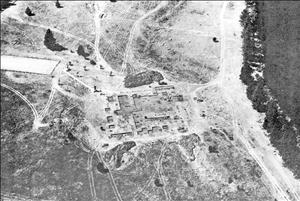In September 1951, archaeology student Ray Carlson locates the grave of Jacques Raphael "Jaco" Finlay (1768-1828) at the site of Spokane House on the Spokane River about 10 miles below downtown Spokane. Jaco (or Jacco) Finlay built the original Spokane House, a fur-trading post located where the Little Spokane River joins the Spokane, in 1810. According to fur-trade lore, Finlay was buried beneath one of the bastions at the time of his death. In the summers of 1950 and 1951, an archaeological dig outlined Spokane House construction footprints during its occupation by three fur companies between 1810 and 1825. Workers remained on the alert for Jaco's grave, which Carlson finally located.
After locating the remains of two stockades in 1950, archaeologist Louis Caywood returned in the summer of 1951 with a team for more excavations. According to Joel Ferris, President of the Eastern Washington State Historical Society at that time, everyone was hoping to find the remnants of a certain bastion.
“It was the day-to-day talk of the boys on the work and of Mr. Caywood that some trace of the grave of Jaco Finlay might be found ... Jaco almost became a familiar friend who was lost, so one September afternoon Ray Carlson, a University of Washington archaeological student, who was working at the southeast corner of the outside line of posts was suddenly seen to be jumping and dancing in great excitement. He had discovered the skeletal remains of Jaco Finlay” (Ferris, 9-10).
The shallow grave exposed by Carlson contained the remnants of a wooden coffin, the bones of a mature male, as well as
a fragment from a bone comb, a tin drinking mug, and a disintegrating hunting knife sheathed in a thin metal scabbard. A three-by-ten-inch portion of writing slate, together with the nosepiece and broken lens from a pair of spectacles, indicated that the person in the grave was educated, and an assortment of pipe bowls suggested a certain fondness for tobacco. There were two pipes of clay, and one carved from wood; a stone bowl that still held the lead ring used to attach a stem, and a copper one beaten smooth. One of the clay pipes had distinct lines scratched into its bowl that formed a rough connected “JF,” and local historians were convinced that the cryptic monogram signified Jaco Finlay.
As was standard practice in archaeological excavations at the time, the artifacts and remains from the dig were stored at the Eastern Washington Historical Society, where they remained for the next two decades. On July 25, 1976, at the request of Jaco’s great granddaughter Jeannette Whitford and several other descendants, Jaco Finlay’s remains were reinterred in a ceremony near the site of the old bastion where he had first been buried over a century before. A marker at the site reads:
Grave.
Jacco Finlay was a clerk in charge of constructing
Spokane House in 1810. Jacco died in 1828 and was buried
here, at his request, under one of the bastions.

